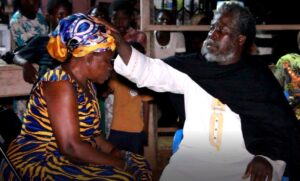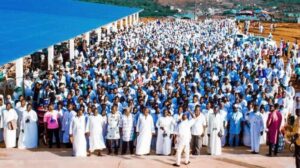
Aspects of Culture in Asomdwee Ntonton Som
Written by Mensah Adinkrah, Ph.D.
As a professor of sociology, my interest in culture, cultural values, norms, and beliefs runs deep. It is with this background that I have developed a keen interest in the culture of the Most High God’s Third Religion, Asomdwee Ntonton Som, founded by Okronkronyi Nyame Somafo Yawoh, the long-awaited Elijah and End Time Messiah.
Culture refers to the way of life or lifestyle of a group. It can be categorized into material and nonmaterial aspects. In the context of religion, these elements define how followers behave, worship, and live. For Asomdwee Ntonton Som, a religious group established and led by Okronkronyi Nyame Somafo Yawoh, both material and nonmaterial cultural practices are evident, even as the religion continues to develop.
Material Culture
Material culture refers to the physical, tangible aspects of a group’s way of life. In the context of Asomdwee Ntonton Som, one key example is:
- Footwear Restriction: Shoes or sandals are prohibited on the Holy Grounds, including the Worship Center. This practice demonstrates reverence for the sacred space and symbolizes humility.
Nonmaterial Culture
Nonmaterial culture consists of the intangible aspects, such as beliefs, norms, and practices. In Asomdwee Ntonton Som, several norms govern behavior, and violation of these norms is considered deviant, warranting sanctions. Some key nonmaterial aspects of the religious culture include:
1. Cardinal Doctrines of Asomdwee Ntonton Som
Cardinal doctrines are the core truths that an individual must accept and practice to enter the Kingdom of God. The fundamental cardinal doctrine of Asomdwee Ntonton Som is the belief in the oneness of God—“God Is One”—and the recognition that Okronkronyi Nyame Somafo Yawoh is a Messenger of God. According to Okronkronyi Nyame Somafo Yawoh, this belief is essential for attaining salvation and will be the key to judgment on the Day of Reckoning.
2. Obedience to Divine Authority: Obedience to divine authority is a central precept of Asomdwee Ntonton Som. Adherents are required to show unwavering obedience to the Most High God, RABBI, as well as to the Messenger of the Most High God, Okronkronyi Nyame Somafo Yawoh. According to Nyame Somafo Yawoh’s teachings, one of the gravest offenses in the eyes of RABBI is the failure to believe in the Messengers sent by Him. Nonbelief in these divinely appointed Messengers is seen as a significant transgression, one that distances individuals from the path of righteousness and divine favor.
3. No Clapping of Hands: Members do not clap to show approval or acknowledgment. Instead, they use a phrase, “Rabbi Ye Kese Oye Kese Ampa,” to express appreciation, emphasizing verbal affirmation over physical applause. Okronkronyi Nyame Somafo Yawoh teaches that the “Clapping of Hands” is one of the creations of Satan.
4. Prohibition of Pork: Eating pork is strictly forbidden. Members who violate this norm lose their baptism and must undergo rebaptism to restore their spiritual status.
5. No Alcohol Consumption: Drinking alcohol is similarly prohibited. Like the pork restriction, consuming alcohol results in the loss of baptism and requires rebaptism.
6. Ban on Drugs: The use of marijuana, cocaine, and other illegal substances is forbidden, reflecting the religion’s emphasis on purity and sobriety.
7. Suicide as a Taboo: Suicide is strongly condemned within Asomdwee Ntonton Som. It is not only a societal taboo but a religious offense. Members are expected to avoid even the contemplation of such acts, as suicide brings disgrace upon the individual and the religious community. Okronkronyi Nyame Somafo Yawoh teaches that suicides will not gain salvation on the day of Judgement.
As Okronkronyi Nyame Somafo Yawoh continues to establish the religion, it is expected that additional cultural practices and norms will be formalized in December 2025, further shaping the identity and way of life for the followers of Asomdwee Ntonton Som.





